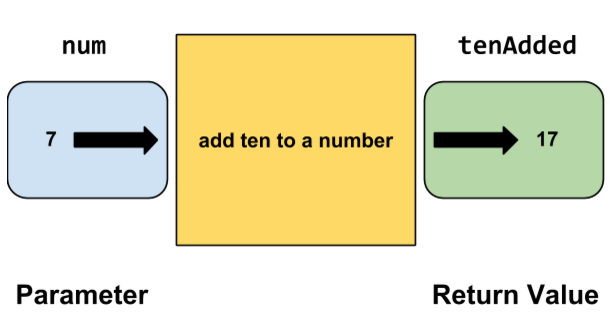Functions and Return Values
Similar to how functions can take in values as parameters, functions can also return values.
Keeping Results
Recall the addTen function from the previous chapter:
function addTen(x){
var xPlusTen = x + 10;
println(xPlusTen);
}

This function takes in a parameter, x, and adds 10 to it. Lastly, the program prints the value to the console.
But what if we wanted to store the value of x plus 10? In the function above, x + 10 is stored into a local
variable called xPlusTen. However, this variable is lost when the function is finished -- it cannot be accessed
outside of the function.
Using a return statement will allow us to pass a value back out of the function. That return value can be stored into a variable for later use.
Here's how to rewrite addTen to return a value instead of printing:
function addTen(x){
var xPlusTen = x + 10;
return xPlusTen;
}
Note that the return keyword does not require parentheses. Also, returning a value does not print that value to the console, similar to how passing in a value as a
parameter does not print the value to the console.
Calling a Function With a Return Value
A return value by itself would not be very useful, given that it does not print to the console. Fortunately, we can store a function's return value into a variable. Take a look at the following code:
var num = 7;
var tenAdded = addTen(7);
First, we create a variable named num and initialize it to 7. Then, we create another variable called tenAdded.
Notice that tenAdded is not given a normal value. Instead, we are setting it equal to addTen(7). This means
that the tenAdded variable will hold the result of whatever the function call addTen(7) returns. We know that
addTen(7) will return 17, so tenAdded will be 17.

Multiple Parameters With a Return Value
Return values work in many situations. For example, we can rewrite the add function from the previous section
to return the sum instead of print it to the screen:
function add(x, y){
var sum = x + y;
return sum;
}
We can now call the function and store its return values
var sum = add(10, 90);
println(sum);
which would print 100 to the console.